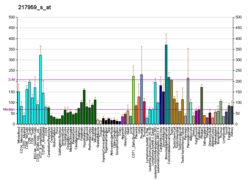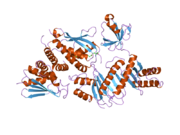| TRAPPC4 |
|---|
 |
| Available structures |
|---|
| PDB | Ortholog search: PDBe RCSB |
|---|
| List of PDB id codes |
|---|
2J3T, 2JSN, 2ZMV |
|
|
| Identifiers |
|---|
| Aliases | TRAPPC4, HSPC172, PTD009, SBDN, SYNBINDIN, TRS23, CGI-104, trafficking protein particle complex 4, NEDESBA, trafficking protein particle complex subunit 4 |
|---|
| External IDs | OMIM: 610971; MGI: 1926211; HomoloGene: 105453; GeneCards: TRAPPC4; OMA:TRAPPC4 - orthologs |
|---|
| Gene location (Human) |
|---|
 | | Chr. | Chromosome 11 (human)[1] |
|---|
| | Band | 11q23.3 | Start | 119,018,763 bp[1] |
|---|
| End | 119,025,454 bp[1] |
|---|
|
| Gene location (Mouse) |
|---|
 | | Chr. | Chromosome 9 (mouse)[2] |
|---|
| | Band | 9|9 A5.2 | Start | 44,314,995 bp[2] |
|---|
| End | 44,318,897 bp[2] |
|---|
|
| RNA expression pattern |
|---|
| Bgee | | Human | Mouse (ortholog) |
|---|
| Top expressed in | - islet of Langerhans
- anterior pituitary
- right testis
- left testis
- stromal cell of endometrium
- ganglionic eminence
- right adrenal gland
- left adrenal gland
- left adrenal cortex
- human kidney
|
| | Top expressed in | - medial ganglionic eminence
- right kidney
- ventricular zone
- neural tube
- morula
- otic placode
- granulocyte
- facial motor nucleus
- dentate gyrus of hippocampal formation granule cell
- embryo
|
| | More reference expression data |
|
|---|
| BioGPS | 
 | | More reference expression data |
|
|---|
|
| Gene ontology |
|---|
| Molecular function | | | Cellular component | - cytosol
- Golgi apparatus
- synaptic vesicle
- synapse
- dendrite
- endoplasmic reticulum
- Golgi stack
- Golgi membrane
- TRAPP complex
| | Biological process | - dendrite development
- COPII vesicle coating
- vesicle-mediated transport
- endoplasmic reticulum to Golgi vesicle-mediated transport
| | Sources:Amigo / QuickGO |
|
| Orthologs |
|---|
| Species | Human | Mouse |
|---|
| Entrez | | |
|---|
| Ensembl | |
|---|
ENSG00000280495
ENSG00000196655 |
| |
|---|
| UniProt | | |
|---|
| RefSeq (mRNA) | NM_016146
NM_001318486
NM_001318488
NM_001318489
NM_001318490
|
|---|
NM_001318492
NM_001318494 |
| |
|---|
| RefSeq (protein) | NP_001305415
NP_001305417
NP_001305418
NP_001305419
NP_001305421
|
|---|
NP_001305423
NP_057230 |
| |
|---|
| Location (UCSC) | Chr 11: 119.02 – 119.03 Mb | Chr 9: 44.31 – 44.32 Mb |
|---|
| PubMed search | [3] | [4] |
|---|
|
| Wikidata |
| View/Edit Human | View/Edit Mouse |
|

 2j3t: THE CRYSTAL STRUCTURE OF THE BET3-TRS33-BET5-TRS23 COMPLEX.
2j3t: THE CRYSTAL STRUCTURE OF THE BET3-TRS33-BET5-TRS23 COMPLEX.




















